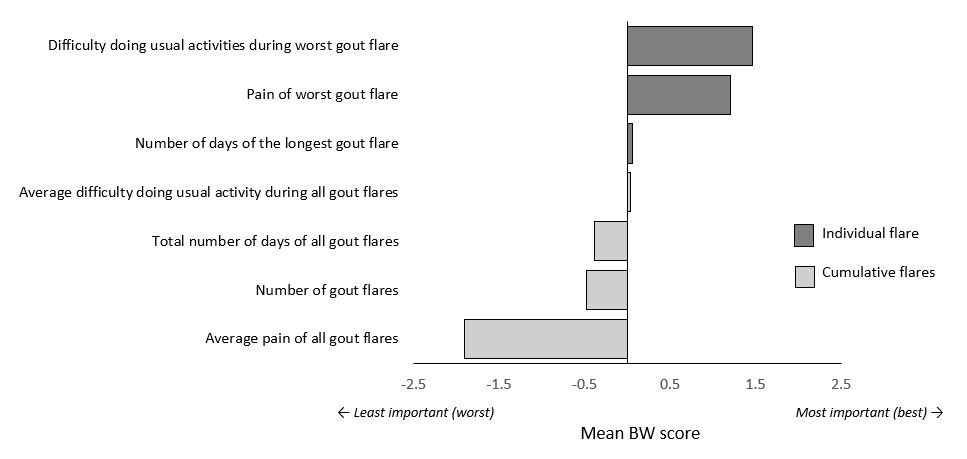Session Information
Date: Sunday, November 7, 2021
Title: Metabolic & Crystal Arthropathies – Basic & Clinical Science Poster I (0660–0682)
Session Type: Poster Session B
Session Time: 8:30AM-10:30AM
Background/Purpose: Several factors contribute to the patient experience of gout flares, including pain intensity, duration, frequency, and disability. It is unknown which of these factors are most important to patients when considering flare burden over time, including those related to the cumulative experience of all flares, or the experience of a single worst flare. This study aimed to determine which flare attributes are the most and least important to the patient experience of flare burden over time.
Methods: Participants were recruited from existing databases of patients who had previously participated in research at the Clinical Research Centre, University of Auckland, Aotearoa/New Zealand. Participants with gout completed an anonymous online survey. Questions were aimed at identifying which attributes of gout flares were the most and least important over a hypothetical six-month period. Four attributes represented the cumulative burden of all flares (average pain of all gout flares, number of gout flares, total number of days of all gout flares, and average difficulty doing usual activities during all gout flares) and three attributes represented the burden of individual flares (pain of the worst gout flare, number of days of the longest gout flare, and difficulty doing usual activities during the worst gout flare). A best-worst scaling method was used to determine the importance hierarchy of the included attributes. Best (B) and worst (W) scores were calculated for each attribute representing the number of times that attribute was chosen as most and least important, respectively. The mean best-minus-worst (BW) score was also calculated to rank the attributes from most to least important, with positive values indicating the attribute being chosen more often as most important, and negative values indicating the attribute being chosen more often as least important.
Results: Fifty participants were included. The majority of participants were New Zealand European middle-aged males and 90% had experienced at least one gout flare in the previous 12 months, with 58% experiencing one to four gout flares in the previous 12 months. Difficulty doing usual activities during the worst flare and pain of the worst flare were ranked as the most important, while average pain of all flares was considered the least important. Overall, attributes related to the single worst gout flare were considered more important than attributes related to the cumulative impact of all flares (Figure).
Conclusion: When thinking about the burden of gout flares over time, patients rank activity limitation and pain experienced during their worst gout flare as the most important contributing factors, while factors related to the cumulative impact of all flares over time are relatively less important. Future studies investigating gout flare prevention should consider capturing outcomes related to the worst gout flare experienced during the follow-up period, specifically those related to activity limitation and pain.
To cite this abstract in AMA style:
Holyer J, Taylor W, Gaffo A, Hosie G, Horne A, Mihov B, Su I, Gamble G, Dalbeth N, Stewart S. Which Attributes Are the Most and Least Important to Patients When Considering Gout Flare Burden over Time? A Best-worst Scaling Choice Study [abstract]. Arthritis Rheumatol. 2021; 73 (suppl 9). https://acrabstracts.org/abstract/which-attributes-are-the-most-and-least-important-to-patients-when-considering-gout-flare-burden-over-time-a-best-worst-scaling-choice-study/. Accessed .« Back to ACR Convergence 2021
ACR Meeting Abstracts - https://acrabstracts.org/abstract/which-attributes-are-the-most-and-least-important-to-patients-when-considering-gout-flare-burden-over-time-a-best-worst-scaling-choice-study/

